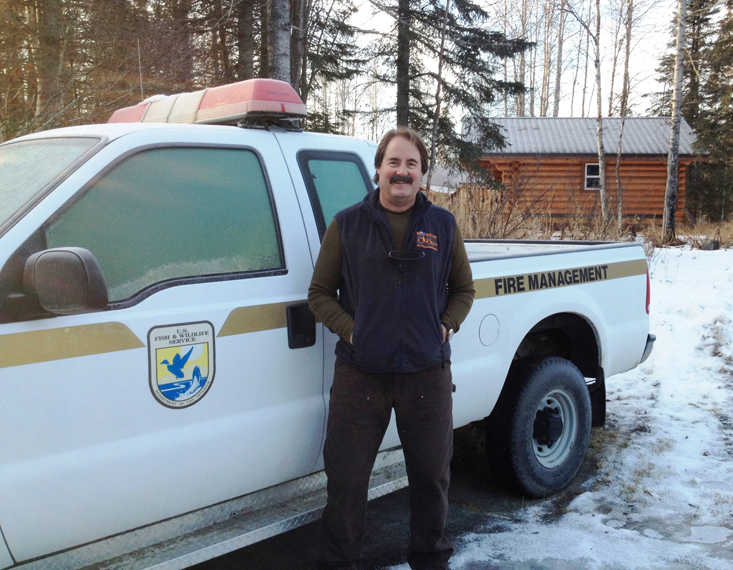After 17 years of service, Doug Newbould retired from the Kenai National Wildlife Refuge. The refuge will feel this loss as Doug has contributed substantially to the management of the fire program and multiple wildfires over the years. But Doug has been a firefighter for much longer than this …
Doug learned to be a firefighter on Bridger-Teton National Forest in Wyoming where he earned his first “red card” (wildland firefighter credential) in 1976. He then moved to White River National Forest where he implemented cooperative prescribed fire projects with the Colorado Division of Wildlife. This is where Doug really “cut his eyeteeth” with fire leadership and developed skills in the application of fire to reduce hazardous fuels and to improve habitat. In 1988, Doug utilized these skills in the well-known Yellowstone fires alongside 9,000 firefighters and 4,000 military personnel.
In 1991, Doug and his wife Denise moved to Kasilof after accepting a timber staff position with Chugach National Forest. While working for the Seward District, he continued to hone skills with vegetation management, mainly through timber salvage sales associated with beetle-killed trees, while also serving as a firefighter. In 1992, the Newboulds purchased their current home in Soldotna where they raised their two children.
Doug was always enthralled with the beauty of Kenai Refuge so he was pretty excited when he got the job here as Assistant Fire Management Officer in 1997. This position was created because fire management was becoming increasingly more complex. In recent decades the Kenai Peninsula had witnessed a warmer and drier climate which triggered a spruce bark beetle epidemic, converting some areas to very flammable grasses, and increased the frequency of lightning storms and natural ignitions. Doug became the Kenai Refuge Fire Management Officer a year later when the incumbent retired. In the early 2000s, fire management on Kodiak Refuge was added to Doug’s duties.
A landmark wildfire season across the U.S. in the late 1990s brought about development of the National Fire Plan. This plan largely focused on hazardous fuel reduction as a means to mitigate severe wildfire risks to communities and natural resources. Fuels are reduced through mechanical treatments or prescribed fire, or by allowing naturally occurring fires to restore fire-adapted ecosystems.
This plan, along with a local Moose Management Plan, provided the framework for completing fuels reduction projects on and adjacent to the refuge. In 1998, Doug spearheaded the design and initiation of the Funny River Road shaded fuel break. Later, prescribed fire was his primary tool for reducing hazardous fuels at Mystery Creek, an effort to reduce the potential of fire moving toward Sterling from refuge lands to the east.
Doug and his staff completed over 1,550 acres of prescribed fire treatments by 2002. That same year, the Lily Lake project was developed in an area of continuous stands of black spruce to create an additional wildfire buffer in the Wildland Urban Interface (WUI), the area where refuge lands are in close proximity to homes.
Along with hazardous fuels treatments, Doug feels that some of his biggest accomplishments on the refuge involved cooperatively managing wildland fires for resource benefits as a Strategic Operational Planner. His list includes Pipe Creek, Fox Creek, Irish Channel, King County Creek, Swan Lake, and Shanta Creek fires. The post-fire effects proved useful in later years to reduce wildland fire intensity, create barriers to wildfire spread, and help restore ecosystems that rely on fire as a disturbance mechanism. In fact, many of these fire scars have played a role in how future fires were able to be managed on the refuge.
Last spring the extremely dry weather and cured grass coupled with strong winds promoted fast growth of the Funny River Fire within a relatively short time period. Many agencies were brought together to assist on this human-caused fire, including resources from the lower 48. Hazardous fuel reductions on the north side of the fire altered fire behavior enough to allow firefighters to safely work and contain fire spread. Additionally, fire scars from the Shanta Creek and King County Creek fires assisted in reducing the intensity and spread of the fire.
The Funny River fire served as a reminder that living with fire is part of living where we do, but the risks can be mitigated by implementing hazardous fuels reductions and applying other “Firewise Principles” to our homes.
Doug says the best part of working at the Kenai Refuge is “the people” — working with refuge staff, multiple agency cooperators, and the community provided great job satisfaction. Within the larger interagency wildland fire community, Doug served on the Alaska Air Quality Committee and also as a charter member of the National Fire Operations Safety Team. Locally, Doug served on the Kenai Peninsula Fire Chiefs Association, the Local Emergency Planning Committee, and the All Hands/All Lands interagency working group. Under the leadership of the Kenai Peninsula Borough, the All Hands/All Lands group works with communities and their Fire Chiefs to complete Community Wildland Fire Protection Plans (CWPPs). Doug served as a federal advisor during the formulation and implementation of multiple CWPPs for communities adjacent to the refuge. Doug stated, “This is my home and I intended to defend it that way” while he served as the Fire Management Officer.
Doug feels that the Kenai Refuge is a spectacular public resource with a great mission. He usually meets his goal of getting out on the refuge canoe system at least once a year, but also enjoys the backcountry alpine areas. Doug has had a great career in some of the most beautiful places in the country, but when asked what is next, he says he is ready to enjoy and explore Alaska with Denise, especially its coastal waters. His last words, “We love the Kenai, it’s our home and we plan to stay involved in our community.”
Kristi Bulock is the new Fire Management Officer at Kenai National Wildlife Refuge. Find more information about the refuge at http://www.fws.gov/refuge/kenai/ or http://www.facebook.com/kenainationalwildliferefuge.

